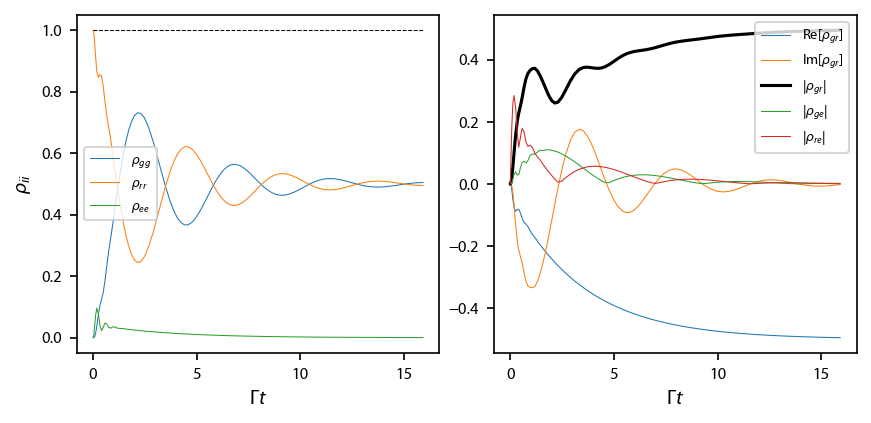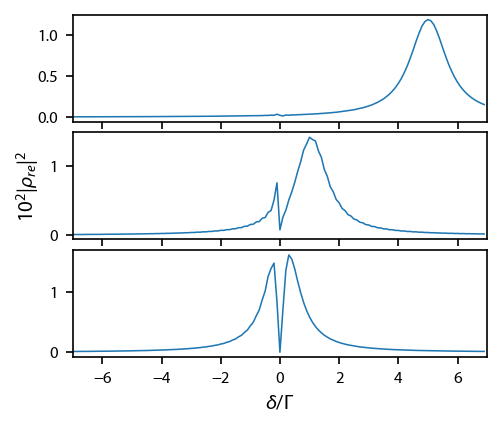Three-level susceptibility & EIT¶
This example demonstrates damped Rabi flopping as calculated with the optical Bloch equations for a three level system and calculates the three-level susceptibility to demonstrate EIT. It the first example with a three-manifold sytem, so we will focus on the construction of the Hamiltonian.
State notation used within:
---- |e>
---- |r>
---- |g>
The three level detuning \(\delta\) and two level detuning \(\Delta\) are the standard detunings for a \(\Lambda\) system.
[1]:
import numpy as np
import matplotlib.pyplot as plt
import pylcp
Define the problem¶
Hamiltonian¶
To construct the three-manifold Hamiltonian, we add the blocks to Hamiltonian one at a time. The order in which they are added is important, as the manifolds are assumed to be in increasing energy order, even though their field-independent elements should already be placed in the appropriate rotating frames, implying that those elements should not contain optical-frequency components.
Our three manifold system is really quite simple, with each manifold containing a single state. Detunings are placed on the \(|r\rangle\) and \(|e\rangle\) states. Finally, the states are connected through \(\pi\)-polarized light. We write a method to return the Hamiltonian given the specified detunings.
[2]:
Delta = -2; delta = 0.
H0 = np.array([[1.]])
mu_q = np.zeros((3, 1, 1))
d_q = np.zeros((3, 1, 1))
d_q[1, 0, 0,] = 1/np.sqrt(2)
def return_three_level_hamiltonian(Delta, delta):
hamiltonian = pylcp.hamiltonian()
hamiltonian.add_H_0_block('g', 0.*H0)
hamiltonian.add_H_0_block('r', delta*H0)
hamiltonian.add_H_0_block('e', -Delta*H0)
hamiltonian.add_d_q_block('g','e', d_q)
hamiltonian.add_d_q_block('r','e', d_q)
return hamiltonian
hamiltonian = return_three_level_hamiltonian(Delta, delta)
hamiltonian.print_structure()
[[(<g|H_0|g> 1x1) None (<g|d_q|e> 1x1)]
[None (<r|H_0|r> 1x1) (<r|d_q|e> 1x1)]
[(<e|d_q|g> 1x1) (<e|d_q|r> 1x1) (<e|H_0|e> 1x1)]]
Lasers and magnetic fields¶
Here, a method returns the lasers for a given intensity. Note that function returns a dictionary of two lasers, one addressing the \(|g\rangle \rightarrow |e\rangle\) transition and the other the \(|r\rangle \rightarrow |e\rangle\) transition. Finally, we assume a constant zero magnitude magnetic field.
[3]:
# First, define the lasers (functionalized for later):
Ige = 4; Ire = 4;
def return_three_level_lasers(Ige, Ire):
laserBeams = {}
laserBeams['g->e'] = pylcp.laserBeams(
[{'kvec':np.array([1., 0., 0.]), 'pol':np.array([0., 1., 0.]),
'pol_coord':'spherical', 'delta':0., 's':Ige}],
beam_type=pylcp.infinitePlaneWaveBeam
)
laserBeams['r->e'] = pylcp.laserBeams(
[{'kvec':np.array([1., 0., 0.]), 'pol':np.array([0., 1., 0.]),
'pol_coord':'spherical', 'delta':0., 's':Ire}],
beam_type=pylcp.infinitePlaneWaveBeam
)
return laserBeams
laserBeams = return_three_level_lasers(Ige, Ire)
# Second, magnetic field:
magField = lambda R: np.zeros(R.shape)
Damped Rabi oscillations¶
We first evolve the optical Bloch equations to see damped Rabi oscillations in the three-level system.
[4]:
obe = pylcp.obe(laserBeams, magField, hamiltonian,
transform_into_re_im=True)
obe.set_initial_rho_from_populations(np.array([0., 1., 0.]))
obe.evolve_density([0, 100])
fig, ax = plt.subplots(1, 2, figsize=(6.5, 2.75))
ax[0].plot(obe.sol.t/2/np.pi, np.real(obe.sol.rho[0, 0]), linewidth=0.5, label='$\\rho_{gg}$')
ax[0].plot(obe.sol.t/2/np.pi, np.real(obe.sol.rho[1, 1]), linewidth=0.5, label='$\\rho_{rr}$')
ax[0].plot(obe.sol.t/2/np.pi, np.real(obe.sol.rho[2, 2]), linewidth=0.5, label='$\\rho_{ee}$')
ax[0].plot(obe.sol.t/2/np.pi, np.real(obe.sol.rho[0, 0]+obe.sol.rho[1, 1]+obe.sol.rho[2, 2]), 'k--', linewidth=0.5)
ax[0].legend(fontsize=7)
ax[0].set_xlabel('$\Gamma t$')
ax[0].set_ylabel('$\\rho_{ii}$')
ax[1].plot(obe.sol.t/2/np.pi, np.real(obe.sol.rho[0, 1]), linewidth=0.5,
label='Re$[\\rho_{gr}]$')
ax[1].plot(obe.sol.t/2/np.pi, np.imag(obe.sol.rho[0, 1]), linewidth=0.5,
label='Im$[\\rho_{gr}]$')
ax[1].plot(obe.sol.t/2/np.pi, np.abs(obe.sol.rho[0, 1]), 'k-',
label='$|\\rho_{gr}|$')
ax[1].plot(obe.sol.t/2/np.pi, np.abs(obe.sol.rho[0, 2]), linewidth=0.5, label='$|\\rho_{ge}|$')
ax[1].plot(obe.sol.t/2/np.pi, np.abs(obe.sol.rho[1, 2]), linewidth=0.5, label='$|\\rho_{re}|$')
ax[1].legend(fontsize=7)
ax[1].set_xlabel('$\Gamma t$')
fig.subplots_adjust(wspace=0.15)

Susceptibility and EIT¶
To see EIT, we want to compute the susceptibility of the laser addressed to the \(|r\rangle \rightarrow |e\rangle\) transition, which is proportional to \(\rho_{re}\). We will use our methods returning the appropriate lasers and Hamiltonian to loop through several three level detunings \(\delta\) and two level detunings \(\Delta\).
[5]:
Deltas = np.array([-5., -1., -0.1])
deltas = np.arange(-7., 7., 0.1)
delta_random = np.random.choice(deltas)
it = np.nditer(np.meshgrid(Deltas, deltas)+ [None,])
laserBeams = return_three_level_lasers(1, 0.1)
for Delta, delta, rhore in it:
hamiltonian = return_three_level_hamiltonian(Delta, delta)
obe = pylcp.obe(laserBeams, magField, hamiltonian,
transform_into_re_im=True)
obe.set_initial_rho_from_populations([0, 1, 0])
obe.evolve_density([0, 2*np.pi*5])
rhore[...] = np.abs(obe.sol.rho[1, 2, -1])
Plot it up:
[6]:
fig, ax = plt.subplots(3, 1, figsize=(3.25, 2.75))
for ii, row in enumerate(it.operands[2].T):
ax[ii].plot(deltas, 1e2*row**2, linewidth=0.75)
ax[ii].set_xlim(-7, 7)
if ii<2:
ax[ii].xaxis.set_ticklabels('')
ax[1].set_ylabel('$10^2|\\rho_{re}|^2$')
ax[-1].set_xlabel('$\delta/\Gamma$')
fig.subplots_adjust(bottom=0.15, left=0.13)

